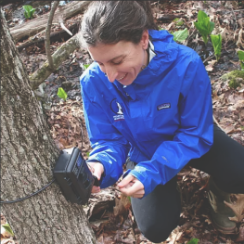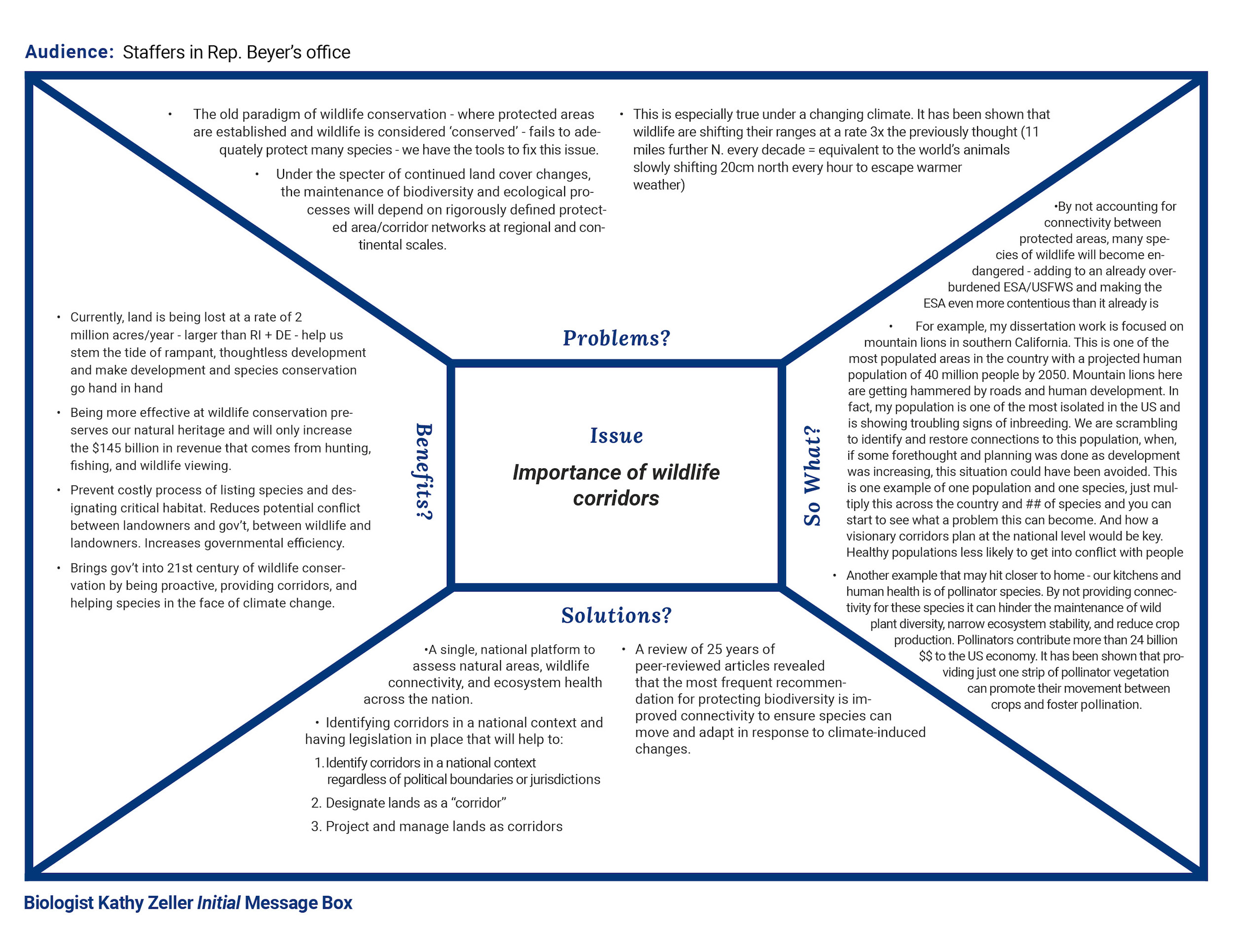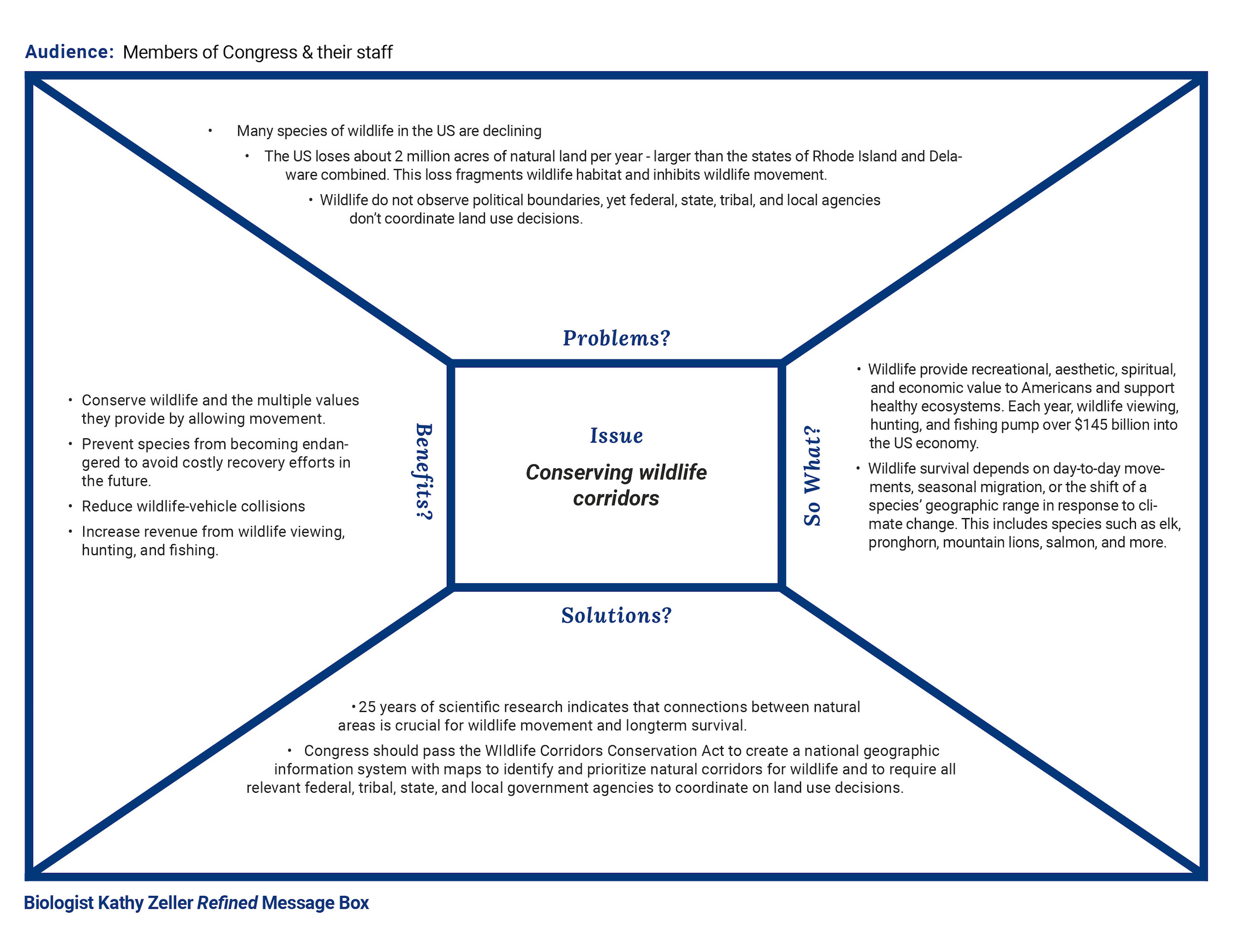Compare
Refining Your Message Box:
Kathy Zeller Example
 Kathy Zeller was a Ph.D. candidate focused on conservation biology at the University of Massachusetts at Amherst when she first worked on a Message Box with COMPASS as part of the Switzer Environmental Fellowship Program, a leadership and communication training program funded by the Robert & Patricia Switzer Foundation.
Kathy Zeller was a Ph.D. candidate focused on conservation biology at the University of Massachusetts at Amherst when she first worked on a Message Box with COMPASS as part of the Switzer Environmental Fellowship Program, a leadership and communication training program funded by the Robert & Patricia Switzer Foundation.
To identify a meaningful audience for her science, Kathy contacted people she knew in conservation groups. She learned that Congressman Don Beyer of Virginia was interested in developing legislation to address wildlife habitat needs, and arranged a meeting with two of his staff. Her first Message Box reflects her initial attempt to distill the science of conservation corridors for the Congressman and his staff in a way that would motivate action and guide the development of effective legislation.
Initial Message Box
Click on image to see larger version
As you can see, Kathy’s Initial Message Box has a lot of detail.
But working on her Message Box prompted her to identify key information from the scientific literature that she realized the Congressman would be interested in, such as the amount of habitat lost each year and the costs associated with inaction. She got the staff’s attention, and that first meeting led to a lot of follow-up communication with the Congressman’s office. They asked Kathy for additional information, such as a summary of conservation benefits based on current scientific understanding. She worked to frame her material in ways that would resonate with the Congressman’s constituents by including information relevant to the Appalachian Trail that runs through Virginia’s Blue Ridge Mountains.
Read Transcribed Message Box Here
Biologist Kathy Zeller Initial Message Box
Audience: Staffers in Rep. Beyer’s office
Issue: Importance of wildlife corridors
Problems?
- The old paradigm of wildlife conservation – where protected areas are established and wildlife is considered ‘conserved’ – fails to adequately protect many species – we have the tools to fix this issue.
- Under the specter of continued land cover changes, the maintenance of biodiversity and ecological processes will depend on rigorously defined protected area/corridor networks at regional and continental scales.
- This is especially true under a changing climate. It has been shown that wildlife are shifting their ranges at a rate 3x the previously thought (11 miles further N. every decade = equivalent to the world’s animals slowly shifting 20cm north every hour to escape warmer weather)
Benefits?
- Currently, land is being lost at a rate of 2 million acres/year – larger than RI + DE – help us stem the tide of rampant, thoughtless development and make development and species conservation go hand in hand
- Being more effective at wildlife conservation preserves our natural heritage and will only increase the $145 billion in revenue that comes from hunting, fishing, and wildlife viewing.
- Prevent costly process of listing species and designating critical habitat. Reduces potential conflict between landowners and gov’t, between wildlife and landowners. Increases governmental efficiency.
- Brings gov’t into 21st century of wildlife conservation by being proactive, providing corridors, and helping species in the face of climate change.
Solutions?
- A single, national platform to assess natural areas, wildlife connectivity, and ecosystem health across the nation.
- Identifying corridors in a national context and having legislation in place that will help to:
- Identify corridors in a national context regardless of political boundaries or jurisdictions
- Designate lands as a “corridor”
- Project and manage lands as corridors
- A review of 25 years of peer-reviewed articles revealed that the most frequent recommendation for protecting biodiversity is improved connectivity to ensure species can move and adapt in response to climate-induced changes.
So What?
- By not accounting for connectivity between protected areas, many species of wildlife will become endangered – adding to an already overburdened ESA/USFWS and making the ESA even more contentious than it already is
- For example, my dissertation work is focused on mountain lions in southern California. This is one of the most populated areas in the country with a projected human population of 40 million people by 2050. Mountain lions here are getting hammered by roads and human development. In fact, my population is one of the most isolated in the US and is showing troubling signs of inbreeding. We are scrambling to identify and restore connections to this population, when, if some forethought and planning was done as development was increasing, this situation could have been avoided. This is one example of one population and one species, just multiply this across the country and ## of species and you can start to see what a problem this can become. And how a visionary corridors plan at the national level would be key. Healthy populations less likely to get into conflict with people
- Another example that may hit closer to home – our kitchens and human health is of pollinator species. By not providing connectivity for these species it can hinder the maintenance of wild plant diversity, narrow ecosystem stability, and reduce crop production. Pollinators contribute more than 24 billion $$ to the US economy. It has been shown that providing just one strip of pollinator vegetation can promote their movement between crops and foster pollination.
Refined Message Box
Click on image to see larger version
Several months after Kathy’s meeting with his staff, Congressman Beyer introduced the Wildlife Corridors Conservation Act. The bill incorporated several key components that Kathy had outlined, including establishing a national database on protected areas and habitat corridors, and directing government agencies to work together to establish corridors. By then, Kathy had become a post-doctoral researcher at San Diego State University Foundation. She drew on her Message Box to craft a letter addressed to members of Congress that was signed by a dozen prominent conservation biologists, reiterating her main points and urging support for the legislation. And she worked with COMPASS to refine her Message Box further. Her Refined Message Box (above) distills the science further and frames it in ways that can engage a wide range of congressional interests, not just Congressman Beyer’s.
Read Transcribed Message Box Here
Biologist Kathy Zeller Refined Message Box
Audience: Members of Congress & their staff
Issue: Conserving wildlife corridors
Problems?
- Many species of wildlife in the US are declining
- The US loses about 2 million acres of natural land per year – larger than the states of Rhode Island and Delaware combined. This loss fragments wildlife habitat and inhibits wildlife movement.
- Wildlife do not observe political boundaries, yet federal, state, tribal, and local agencies don’t coordinate land use decisions.
Benefits?
- Conserve wildlife and the multiple values they provide by allowing movement.
- Prevent species from becoming endangered to avoid costly recovery efforts in the future.
- Reduce wildlife-vehicle collisions
- Increase revenue from wildlife viewing, hunting, and fishing.
Solutions?
- 25 years of scientific research indicates that connections between natural areas is crucial for wildlife movement and longterm survival.
- Congress should pass the WIldlife Corridors Conservation Act to create a national geographic information system with maps to identify and prioritize natural corridors for wildlife and to require all relevant federal, tribal, state, and local government agencies to coordinate on land use decisions.
So What?
- Wildlife provide recreational, aesthetic, spiritual, and economic value to Americans and support healthy ecosystems. Each year, wildlife viewing, hunting, and fishing pump over $145 billion into the US economy.
- Wildlife survival depends on day-to-day movements, seasonal migration, or the shift of a species’ geographic range in response to climate change. This includes species such as elk, pronghorn, mountain lions, salmon, and more.
More from the Message Box
Interested in going beyond the Message Box and hosting a training?
Build your confidence and communication skills through our customizable workshops, or inquire about 1:1 coaching for a specific engagement opportunity.

